Jigsaw puzzles from Japan
The Attic
Deleted puzzles
This page shows puzzles that are no longer available, just for historical curiosity, and for completeness.
In some cases puzzles are reissued with a different code number: if you have the old code number from somewhere, this page should show you the replacement (which may still be available).
2016 pieces
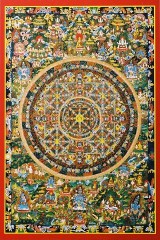 © Epoch Tibetan mandalaA veritable cornucopia of little personages (Buddhas?) doing their own things - sitting on tables, growing extra arms, riding tigers, doing the lotus position, or just being geometrically arranged. The original title, Kongôkai Mandara (or Kongoukai) is the Japanese way of reading the Chinese characters which are the translation of the Sanskrit "Vajradhatu mandala", which means something like "The Mandala of the Indestructible Realm". This Vajra, sometimes called "Diamond" or "Adamantine," is apparently a feature of the Tibetan version of Buddhism; it also appears to refer to four guardian warriors that protect the Buddha, and sure enough, within the big circle of this design, there are four principal surrounding figures. A complicated story, a complicated image, and a puzzle that is only for those who really want a challenge! A web search on "Vajradhatu mandala" shows many old paintings with this title; plainly this is a modern interpretation of the same theme, but there is no indication of the artist. 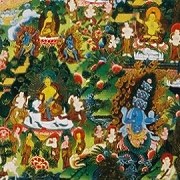
 Permanently unavailable Permanently unavailableAn Epoch puzzle: 2016 pieces; 500 x 750 mm (20" x 30") Code: E23006 (23-006 on package) Retail price ¥3000 |
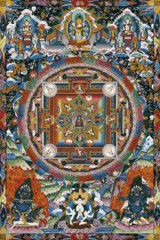 © Epoch Tibetan mandalaA fairly conventional mandala, full of the usual characters. Notably Mahakala, who is blue, in flames, and usually treading on a corpse or two, appears in both lower corners... 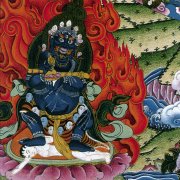
 Permanently unavailable Permanently unavailableAn Epoch puzzle: 2016 pieces; 500 x 750 mm (20" x 30") Code: E23041 (23-041 on package) Retail price ¥3000 |
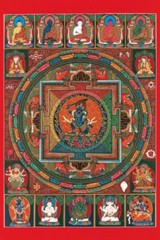 © Roukyu / Gaten Project Achala mandalaAchala (or Acala) is one of the five wisdom-kings of the womb realm, and a popular figure of veneration in Japan, where he is known as Fudou, or "Immovable", a translation of the Sanskrit name.
 Permanently unavailable Permanently unavailableAn Epoch puzzle: 2016 pieces; 500 x 750 mm (20" x 30") Code: E27108 (27-108 on package) Retail price ¥3900 |
2000 pieces
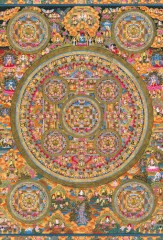 © Beverly Enterprises Vajradhatu mandalaThis is the mandala of the Diamond Realm — there must be several hundred Buddhas figures in an intricate geometrical arrangement. The original title, Kongôkai mandara (or Kongoukai) is the Japanese way of reading the Chinese characters which are the translation of the original Sanskrit "Vajradhatu mandala". 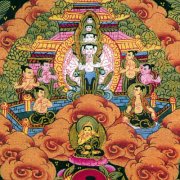
 Permanently unavailable Permanently unavailableA Beverly puzzle: 2000 pieces; 490 x 720 mm (19" x 28") Code: BS62512 (S62-512 on package) Retail price ¥3000 |
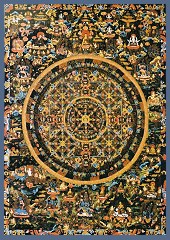 © Epoch Tibetan mandalaA veritable cornucopia of little personages (Buddhas?) doing their own things - sitting on tables, growing extra arms, riding tigers, doing the lotus position, or just being geometrically arranged. The original title, Kongôkai Mandara (or Kongoukai) is the Japanese way of reading the Chinese characters which are the translation of the Sanskrit "Vajradhatu mandala", which means something like "The Mandala of the Indestructible Realm". This Vajra, sometimes called "Diamond" or "Adamantine," is apparently a feature of the Tibetan version of Buddhism; it also appears to refer to four guardian warriors that protect the Buddha, and sure enough, within the big circle of this design, there are four principal surrounding figures. A complicated story, a complicated image, and a puzzle that is only for those who really want a challenge! A web search on "Vajradhatu mandala" shows many old paintings with this title; plainly this is a modern interpretation of the same theme, but there is no indication of the artist. 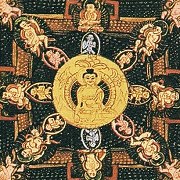  Permanently unavailable Permanently unavailableAn Epoch puzzle: 2000 pieces; 730 x 1020 mm (29" x 40") Code: E20108 (20-108 on package) Retail price ¥4800 |
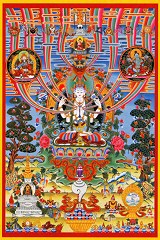 © Epoch Om mani padme hum
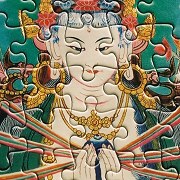  Permanently unavailable Permanently unavailableAn Epoch puzzle: 2000 pieces; 730 x 1020 mm (29" x 40") Code: E20112 (20-112 on package) Retail price ¥4800 |
1500 pieces
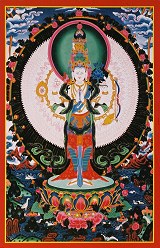 © Epoch Kannon MandalaThis is Avalokitêsvara, the Buddha of eleven faces and 1,000 hands. Somehow, the original character is a Tibetan god, but by the time he reached China, he had become female, with the name Guanyin, which became Kannon in Japanese. Though often known as the "Goddess of Mercy," strictly she is not a goddess, but a Bodhisattva, an incarnation of the Buddha. In the detail below you can see half a dozen or so of her hands: the white circle around her consists of most of the remaining one thousand packed into a tight fan. 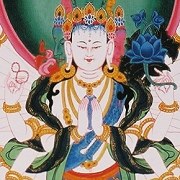
 Permanently unavailable Permanently unavailableAn Epoch puzzle: 1500 pieces; 500 x 750 mm (20" x 30") Code: E15036 (15-036 on package) Retail price ¥3000 |
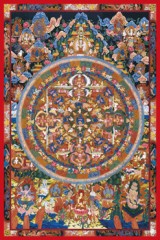 © Epoch Dharmapala MandalaAnother extremely intricate image, but based on the classic geometrical mandala design. Lots of figures, some recognisable - in the middle at the top is a Kannon with one thousand arms and ten faces.
 Permanently unavailable Permanently unavailableAn Epoch puzzle: 1500 pieces; 500 x 750 mm (20" x 30") Code: E15037 (15-037 on package) Retail price ¥3000 |
1053 pieces
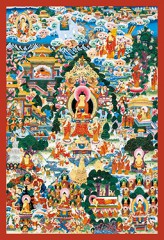 © Apollo Shaka mandalaA mandala is a portrayal of the Buddhist conception of the cosmos, and Shaka is the Japanese form of S(h)akyamuni, one of the personages of Buddha. Here we see lots of people doing interesting things; at least one donkey, four elephants, and various dragons. There is no indication of who painted this picture, though it appears to be a modern version. 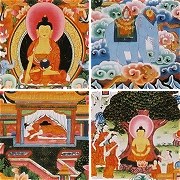
 Permanently unavailable Permanently unavailableDiscontinued June 2018 An Apollo puzzle: 1053 pieces; 260 x 380 mm (10" x 15") Code: P49502 (49-502 on package) Retail price ¥2400 |
1000 pieces
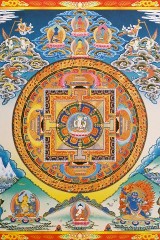 © Dev Kumar Lama Kannon Bodhisattva mandalaThe classic mandala pattern, representing the cosmos, with a ring of fire surrounding the four-gated palace, in the centre of which sits the Bodhisattva Kannon. Various characters populate the outside, heavenly ones at the top, and more worldly at the bottom - particularly a typically blue and angry-looking Mahakala. 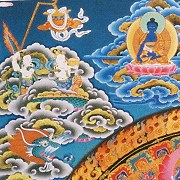
 Permanently unavailable Permanently unavailableAn Appleone puzzle: 1000 pieces; 500 x 750 mm (20" x 30") Code: A10493 (1000-493 on package) Retail price ¥3600 |
 © Dev Kumar Lama Kuze Bodhisattva mandalaA pastoral feeling to this mandala. The central figure, presumably Kuze, another persona of Kannon, sits four-armed on a lotus blossom, immediately surrounded by birds and flowers. The characters at the top look heavenly, while those at the bottom look less friendly, particularly the typically angry-looking Mahakala in the lower right corner. 
 Permanently unavailable Permanently unavailableDiscontinued December 2017 An Appleone puzzle: 1000 pieces; 500 x 750 mm (20" x 30") Code: A10494 (1000-494 on package) Retail price ¥3600 |
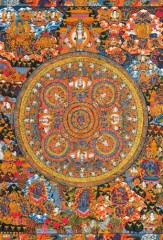 © Beverly Enterprises Shakyamuni Buddha mandalaA classic mandala, with literally hundreds of little figures, both inside and outside the circular inner realm. Shakyamuni Buddha is another name for the Buddha, literally "The Awakened One of the Shakya Clan."  Permanently unavailable Permanently unavailableA Beverly puzzle: 1000 pieces; 490 x 720 mm (19" x 28") Code: B61349 (61-349 on package) Retail price ¥3000 |
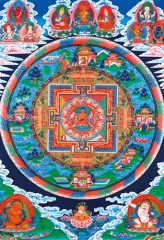 © Hiroshi Yagi Shaka Nyorai mandalaShaka Nyorai is the Buddha, sitting serenely in the middle of this world-view, and surrounded by more holy figures—outside this inner sanctum are scenes from the profane world, of lotus ponds, music, and the rest. 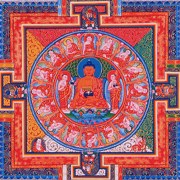
 Permanently unavailable Permanently unavailableA Beverly puzzle: 1000 pieces; 260 x 380 mm (10" x 15") Code: BM81508 (M81-508 on package) Retail price ¥2200 |
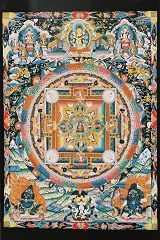 © Epoch Mahakala mandalaMahakala is a Bodhisattva, one of the personages of Buddha, with a wrathful side to his characters. He appears in both lower corners of the picture here, trampling on an outstretched lady. Hmm, well, it's often difficult to tell the boys from the girls in these pictures, but in contrast to this violence, the top centre vignette fairly clearly shows a couple embracing. (The exact configuration is difficult to determine, since characters frequently have four, six, or more arms.) Detail shows the embrace (top centre). 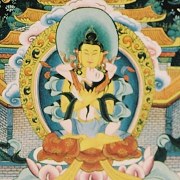 Essay on Mahakala by Tom Suchan and Chaya Chandrasekhar - describes him as "characteristically depicted with an angry face, pot-bellied, and standing on a human corpse or the elephant-headed, Hindu god, Ganesha"  Permanently unavailable Permanently unavailableAn Epoch puzzle: 1000 pieces; 500 x 750 mm (20" x 30") Code: E11009 (11-009 on package) Retail price ¥3000 |
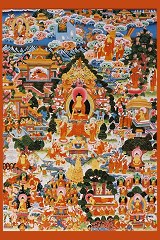 © Epoch Shaka mandalaA mandala is a portrayal of the Buddhist conception of the cosmos, and Shaka is the Japanese form of S(h)akyamuni, one of the personages of Buddha. Here we see lots of people doing interesting things; at least one donkey, four elephants, and various dragons. There is no indication of who painted this picture, though it appears to be a modern version. 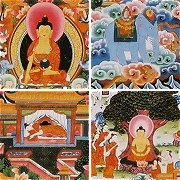  Permanently unavailable Permanently unavailableAn Epoch puzzle: 1000 pieces; 500 x 750 mm (20" x 30") Code: E11010 (11-010 on package) Retail price ¥3000 |
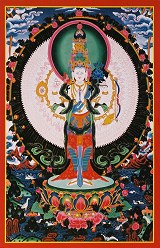 © Epoch Kannon MandalaThis is Avalokitêsvara, the Buddha of eleven faces and 1,000 hands. Somehow, the original character is a Tibetan god, but by the time he reached China, he had become female, with the name Guanyin, which became Kannon in Japanese. Though often known as the "Goddess of Mercy," strictly she is not a goddess, but a Bodhisattva, an incarnation of the Buddha. In the detail below you can see half a dozen or so of her hands: the white circle around her consists of most of the remaining one thousand packed into a tight fan.   Permanently unavailable Permanently unavailableAn Epoch puzzle: 1000 pieces; 500 x 750 mm (20" x 30") Code: E11039 (11-039 on package) Retail price ¥3000 |
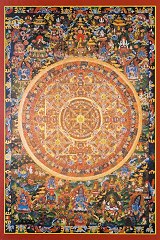 © Epoch Tibetan mandalaA veritable cornucopia of little personages (Buddhas?) doing their own things - sitting on tables, growing extra arms, riding tigers, doing the lotus position, or just being geometrically arranged. The original title, Kongôkai Mandara (or Kongoukai) is the Japanese way of reading the Chinese characters which are the translation of the Sanskrit "Vajradhatu mandala", which means something like "The Mandala of the Indestructible Realm". This Vajra, sometimes called "Diamond" or "Adamantine," is apparently a feature of the Tibetan version of Buddhism; it also appears to refer to four guardian warriors that protect the Buddha, and sure enough, within the big circle of this design, there are four principal surrounding figures. A complicated story, a complicated image, and a puzzle that is only for those who really want a challenge! This is exactly the same design as the 2000-piece Tibetan mandala, but the foil printing allows halos and other features to appear in gold, silver, and deep copper tints.
 Permanently unavailable Permanently unavailableAn Epoch puzzle: 1000 pieces; 500 x 750 mm (20" x 30") Code: E13237 (13-237 on package) Retail price ¥3900 |
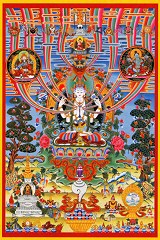 © Epoch Om mani padme hum
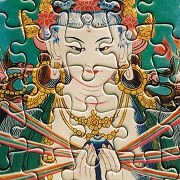
 Permanently unavailable Permanently unavailableAn Epoch puzzle: 1000 pieces; 500 x 750 mm (20" x 30") Code: E13238 (13-238 on package) Retail price ¥3900 |
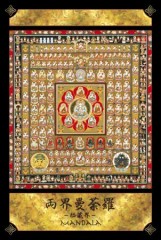 © Yanoman Taizoukai mandalaThis is the Womb World mandala, or Taizoukai mandala in Japanese (Garbhadhatu Mandala in Sanskrit) — the other aspect of the cosmos from the Kongoukai or Adamantine mandala. This is a modern painting by the Nepalese Suriya Lama (born 1959), but closely follows the traditional layout, with more than one hundred little Buddha figures surrounding the central Dainichi Nyorai. This is an exotic puzzle, which will not be easy!  Permanently unavailable Permanently unavailableA Yanoman puzzle: 1000 pieces; 500 x 750 mm (20" x 30") Code: Y101159 (10-1159 on package) Retail price ¥3000 |
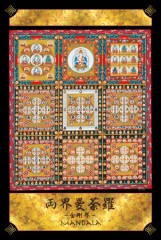 © Surya Lama Vajradhatu mandala (Surya Lama)The nine-panel pattern is a common mandala theme, with another nine circles nested within most of the panels. The original title of this painting is actually "The mandala of the two realms", but it has the subtitle of the Diamond realm, or Vajradhatu. 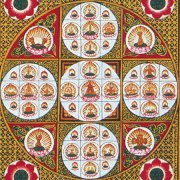 A young Tibetan artist in Nepal, Surya Lama served apprenticeship in a monastery, and is now a fully-fledged painter of mandalas.  Permanently unavailable Permanently unavailableA Yanoman puzzle: 1000 pieces; 500 x 750 mm (20" x 30") Code: Y101181 (10-1181 on package) Retail price ¥3000 |
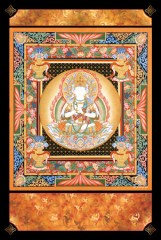 © Mangal Lama Dainichi Nyorai mandala (Mangal Lama)The central figure in this mandala is the Buddha known in Japan as Dainichi Nyorai, or Mahavairocana in Sanskrit. The central circle here is surrounded by a geometrical arrangement of flowers and a kind of urn or teapot in each corner. 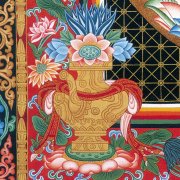 Born in 1958, Mangal Lama studied under his father, a priest in Darjeeling, India. Becoming a Lama at the age of 28 he is now a holy artist of Tibetan Buddhism.  Permanently unavailable Permanently unavailableA Yanoman puzzle: 1000 pieces; 500 x 750 mm (20" x 30") Code: Y101182 (10-1182 on package) Retail price ¥3000 |
300 pieces
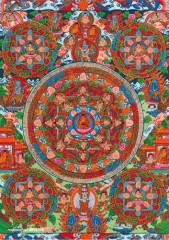 © Beverly Enterprises Shakyamuni Buddha mandalaThe mystery of the cosmos, in tiny pieces! Shakyamuni is another of the names of Gautama Buddha, and in its abbreviated form assimilated into Japanese forms one of the commonest ways of referring to Buddha, viz Shaka-sama.
 Permanently unavailable Permanently unavailableA Beverly puzzle: 300 pieces; 148 x 210 mm (6" x 8") Code: BS73575 (S73-575 on package) Retail price ¥1000 |
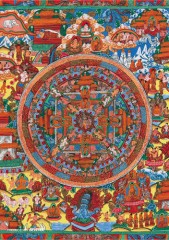 © Beverly Enterprises Chakrasamvara mandalaChakrasamvara is a deity from the Tibetan tradition of Tantric Buddhism... outside the central circle this mandala shows us an amazing variety of scenes, including elephants and other animals, entertainers, and more.
 Permanently unavailable Permanently unavailableA Beverly puzzle: 300 pieces; 148 x 210 mm (6" x 8") Code: BS73576 (S73-576 on package) Retail price ¥1000 |
216 pieces
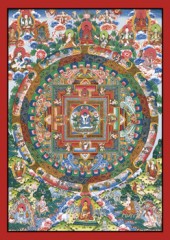 © Epoch Jakujôson mandalaA classic mandala design, of worlds within worlds. At 216 small pieces, this would make a delightful introduction to the art of mandala puzzling - but with the usual number of tiny figures, there must be almost one per piece.
 Permanently unavailable Permanently unavailableAn Epoch puzzle: 216 pieces; 182 x 257 mm (7" x 10") Code: E04007 (04-007 on package) Retail price ¥1200 |
- 24 puzzles shown
- Explore the attics: complete list of deleted puzzles
Substituted puzzles
E22040: this puzzle reissued as E20108 - Tibetan mandala (2000pcs)
BM81507: this puzzle reissued as BM81557 - Kannon mandala (1000pcs)

 This puzzle has smaller pieces than the standard size.
This puzzle has smaller pieces than the standard size. Kannon sits in the four-armed pose associated with this, the most famous of Buddhist mantras: "Om mani padme hum." The six syllables appear in the Tibetan alphabet in various places through the picture, together with a cornucopia of details, from snakes and vultures to peacocks in trees. The detail on the left shows the mantra at the base of one of the stupas - it seems that the six characters are the part within the pink rectangle.
Kannon sits in the four-armed pose associated with this, the most famous of Buddhist mantras: "Om mani padme hum." The six syllables appear in the Tibetan alphabet in various places through the picture, together with a cornucopia of details, from snakes and vultures to peacocks in trees. The detail on the left shows the mantra at the base of one of the stupas - it seems that the six characters are the part within the pink rectangle.